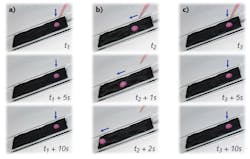Microfluidic systems depend on the controllable movement of liquids or liquid droplets on the surface of a substrate. Unfortunately, such control is not always possible on two-dimensional substrates like graphene. But by using a paraffin-infused porous graphene film (PIPGF) and near-infrared (near-IR) illumination, researchers at Southeast University (Nanjing, China) and Suzhou University of Science and Technology (Suzhou, China) have enabled microfluidics on graphene, and have demonstrated the programmed movement of liquid droplets across a graphene surface.
After fabricating a 300-µm-thick porous honeycombed graphene structure through ionic bonding and acid reduction followed by a freeze-drying process, paraffin wax was liquified to permeate the porous graphene substrate. This PIPGF structure exhibits, at room temperature, strong capillary action that pins liquid droplets to the surface of the graphene. But when 808 nm near-IR light is applied, the wettability of the graphene can be controlled such that surface droplets slide down the substrate when tilted. This process is easily reversed by turning off the illumination and, furthermore, the intensity of near-IR light can control the amount of time before the paraffin is liquified to enable droplet movement. By creating a near-IR mask to control the spatiotemporal wettability of the graphene substrate, microfluidic channels in custom patterns can be created for a variety of applications. Reference: J. Wang et al., Sci. Adv., 4, 9, eaat7392 (Sep. 14, 2018).

